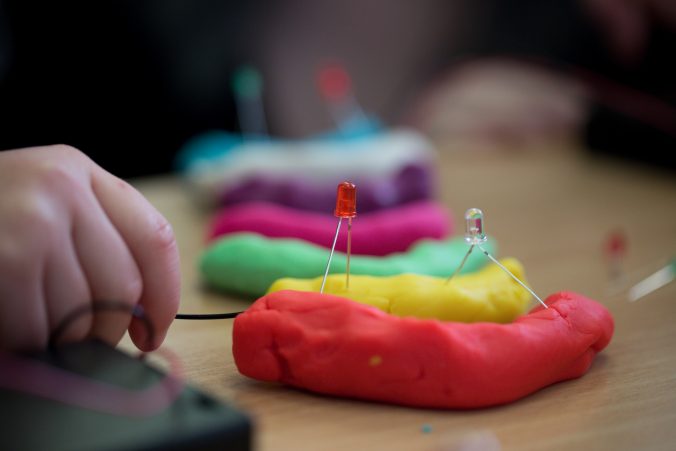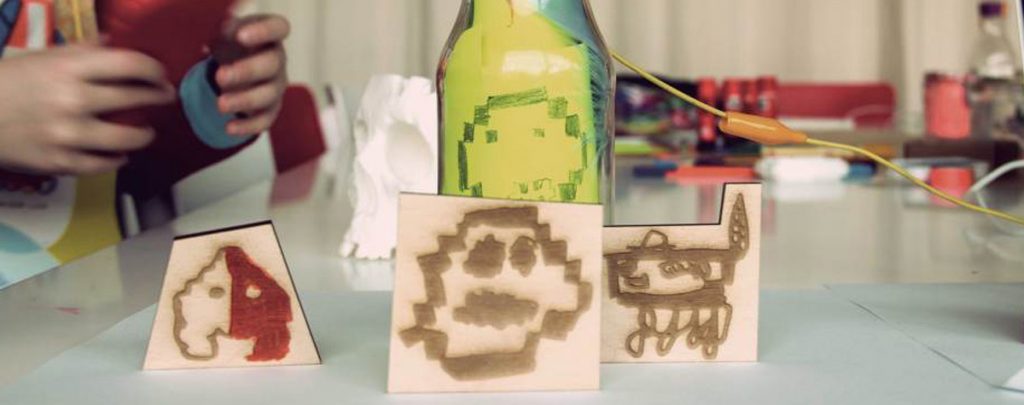Tag: Makerspaces

MakEY Makes Deep Connections: Final Thoughts Before My Final Inquiry
My aim at the onset of EDCI: Interactive and Multuimedia Learning had been “to find new and accessible ways to incooperate ideas regarding technology that come from communities outside of North America” (Welcome Post, Sep 2019). However, course readings and resources, sources referenced by classmates, and related articles I came across along the way, have all together led me down a different path.
Here is the evolution of my inquiry questions thus far: How is technology being approached in ECE environments in countries outside N.America? To: Is there evidence of pedagogy that presents digital technology holistically? And finally: Can “Making” support digital literacy in Early Years Education?
During the formulation of my last post, on a hunt for media related to Confronting the Challenges of Participatory Culture: Media Education for the 21st Century (Jenkins et al., 2006), I came across a playful and opinative video that initiated a fresh line of reasoning. Have a watch:
One specific statement made by Jenkins (2009) evoked memories of similar statements made by Galloway with regard to making:
“We learn by failing. We learn by making mistakes, and doing something over, and doing it better. When our schools make failure fatal they cut themselves off from the most vital process of learning there is. That is, learning through our own mistakes, thinking critically at our own behaviour.” -Jenkins
Both in conversation with our class during a recent video chat (Nov 2019), and through her MEd Project (2015), Galloway articulated the importance of a “Growth Mindset” and leaving room for error. In addition, Marsh et al., in their MakEY publication, entitled Makerspaces in the Early Years: A Literature Review, made reference to the value present in failing and the reflection invariably connected to it (Marsh et al., 2017).
The aforementioned connections led to a consideration of other links that might exist between the making presented in both Galloway’s (2015) work and several MakEY project publications (Marsh et al., 2017,2018), and the new media education presented by Jenkins et al. (2006). I began to distinguish similarities amongst philosophies surrounding both creativity and citizenship. Ultimately, the above YouTube video led me to my final inquiry question.
However, before I present my final post connected to Assignment 2 in EDCI: Interactive and Multimedia Learning, I feel it is necessary to provide a short introduction to Making, Makerspaces, and MakEY …
In 2005, Dale Dougherty founded Make Magazine and, some would argue, popularized the term making (Marsh et al., 2017). Dougherty (2013) described the mindset of a maker as one of a growth mindset: a belief that anything can be accomplished as long as one is equipped with the knowledge required to do so (p.10). The Make Magazine, and subsequent Maker Faire in 2006, marked the beginning of the “do it yourself” culture known as the Maker Movement (Marsh et al., 2017). In 2006, innovator and entrepreneur, Mark Hatch, founded Techshop, a for profit makerspace in California, and later wrote The Maker Movement Manifesto (2013). In The Maker Movement Manifesto (2013), Hatch outlines what he considered to be the core principles of the Maker Movement:
MAKE – Making is fundamental to what it means to be human. We must make, create and express ourselves to feel whole. There is something unique about making physical things.
SHARE – Sharing what you have made and what you know about making with others [..]. You cannot make and not share.
GIVE – There are few things more selfless and satisfying than giving away something you have made.
LEARN – You must learn to make. You must always seek to learn more about your making. You may become a journeyman or master craftsman, but you will still learn, want to learn and push yourself to learn new techniques, materials and processes. Building a lifelong learning path ensures a rich and rewarding making life and, importantly, enables one to share.
TOOL UP – You must have access to the right tools for the project to hand. Invest in and develop local access to the tools you need to do the making you want to do.
PLAY – Be playful with what you are making, and you will be surprised, excited and proud of what you discover.
PARTICIPATE – Join the Maker Movement and reach out to those around you […].
SUPPORT – This is a movement, and it requires emotional, intellectual, financial, political and institutional support. The best hope for improving the world is us, and we are responsible for making a better future.
CHANGE – Embrace the change that will naturally occur as you go on the maker journey. Since making is fundamental to what it means to be human, you will become a more complete version of you as you make.
-Hatch, 2013
At its outset, innovation and ingenuity were recognized as key components of maker culture, along with the development of certain craft skills (Marsh et al., 2017), however, today’s maker culture welcomes a myriad of making experiences and represents an inclusive environment within which to create (Schrock, 2014).
Making itself is deeply rooted in the values of constructivism and bears close resemblance to the succeeding constructionist learning theory set forth by Seymour Papert (1980). Making provides space and opportunity for makers to construct knowledge through experiementation, in a space that motivates curiosity, hands-on experiences, and self directed learning (Dewey, 1902). Mistakes and miscalculations are also considered an important part of maker culture as with them comes opportunity to think criticaly, value persistence, overcome difficulties, and generate collaboration amongst learners (Galloway, 2015; Martin, 2015).
Makerspaces refer to collective spaces that supply individuals with an environment to create through hands-on effort. Using the materials at hand, makers are free to work on a project that is either personally or collectively meaningful. In addition, the specific materials provided in a makerspace are considered the “glue” that pulls makers together for collaborative, creative work (Marsh et al.,2017). The teaching-learning practices and demographics within makerspaces are often wide in scope as they include an assortment of ages, genders, levels of understanding and proficiencies (Halverson &Sheridan, 2014). Therefore, makerspaces often promote peer collaboration and introduce fresh perspectives on teacher-learner dynamics (Marsh et al.,2017).
Today, makerspaces are more widely recognized for their educational value, specifically with regard to their ability to promote problem-solving skills and the development of competences connected to engineering, creative design, and innovation (Stager, 2013). In addition, more and more literature is being produced that explores the value of making and makerspaces in the development of digital literacy, including several publications presented by the MakEY project.
The MakEY project encompasses several small scale, qualitative research projects, in seven European countries and the USA, that aim to examine the way in which making can contribute to children’s digital literacy and creative design skills (“Makey Project”, 2019). All workshops or projects undertaken by MakEY are observed by a team of researchers who utilize recorded observations, field notes, photos and/or video recordings, and, in some cases, footage collected from children wearing GoPro cameras (Marsh et al., 2018).
The few documentations I have observed from MakEY, demonstrate how technology can be incoporated into early learning environments in deep and meaningful ways: the children involved were provided an opportunity to construct knowledge corresponding to their natural environments, their communities, medians (both digital and tactile), and the culture of creating.
MakEY sets forth, as does Galloway (2015) and Jenkins et al. (2006), in their respective works, that intregrating pedagogies connected to design can benefit learners because they encourage mistakes, repetitive operations, and reflection (Marsh et al., 2017).
Until next time. Thanks for reading,
EJ
Up next … Final post connected to Assignment 2 (look for the tag)
References
Dewey, J. (1902). The child and the curriculum. Chicago: The University of Chicago Press.
Dougherty, D. (2013). The maker mindset. Design, make, play: Growing the next Generation of STEM Innovators, 7–11.
Galloway, A. (2015). Bringing a reggio emilia inspired approach into higher grades- Links to 21st century learning skills and the maker movement. MEd Projects (Curriculum and Instruction): University of Victoria, BC.
Halverson, E.R., & Sheridan, K. (2014). The maker movement in education. Harvard Educational Review, 84(4), p 495–504.
Hatch, M. (2013). The Maker Movement Manifesto. New York: McGraw-Hill.
Jenkins, H (2006). Confronting the challenges of Participatory Culture: Media education for the 21st century. The John D. and Catherine T. MacArthur Foundation: Chicago, IL. Retrieved from http://www.oapen.org/download/?type=document&docid=1004003
Marsh, J., Arnseth, H.C. and Kumpulainen, K. (2018) Maker Literacies and Maker Citizenship in the MakEY (Makerspaces in the Early Years) Project. Multimodal Technologies and Interaction, 2(3), 50; https://doi.org/10.3390/mti2030050
Marsh, J., Kumpulainen, K., Nisha, B., Velicu, A., Blum-Ross, A., Hyatt, D., Jónsdóttir, S.R., Levy, R., Little, S., Marusteru, G., Ólafsdóttir, M.E., Sandvik, K., Scott, F., Thestrup, K.,Arnseth, H.C., Dýrfjörð, K., Jornet, A., Kjartansdóttir, S.H., Pahl, K., Pétursdóttir, S. and Thorsteinsson, G. (2017) Makerspaces in the Early Years: A Literature Review. University of Sheffield: MakEY Project.
Martin, L. (2015). The promise of the maker movement for education. Journal of Pre-College Engineering Education Research, 5(1), p 30–39.
Pfbconvergencia. (Oct 12, 2009) Proyecto Facebook [Video File]. Retrieved from https://youtu.be/MmEFefoe-9U
Schrock, A. (2014). “Educationindisguise”: Culture of a hacker and makerspace. Interactions: UCLA. Journal of Education and Information Studies, 10 (1), p 1-25. Retrieved from: http:// escholarship.org/uc/item/0js1n1qg
Stager, G. S. (2013). Papert’s prison fab lab : Implications for the maker movement and education design. IDC ’13 Proceedings of the 12th International Conference on Interaction, p 487–490.

Community